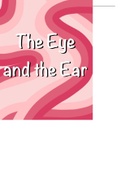Samenvatting
Summary The eye and the ear Gr 11 & G12 life sciences notes
- Vak
- Instelling
Detailed notes of the eye and the ear, part of the nervous system section. Including: The structure of the eye The functioning of the eyeball Visual defects The structure of the ear The functioning of the ear Hearing defects
[Meer zien]




